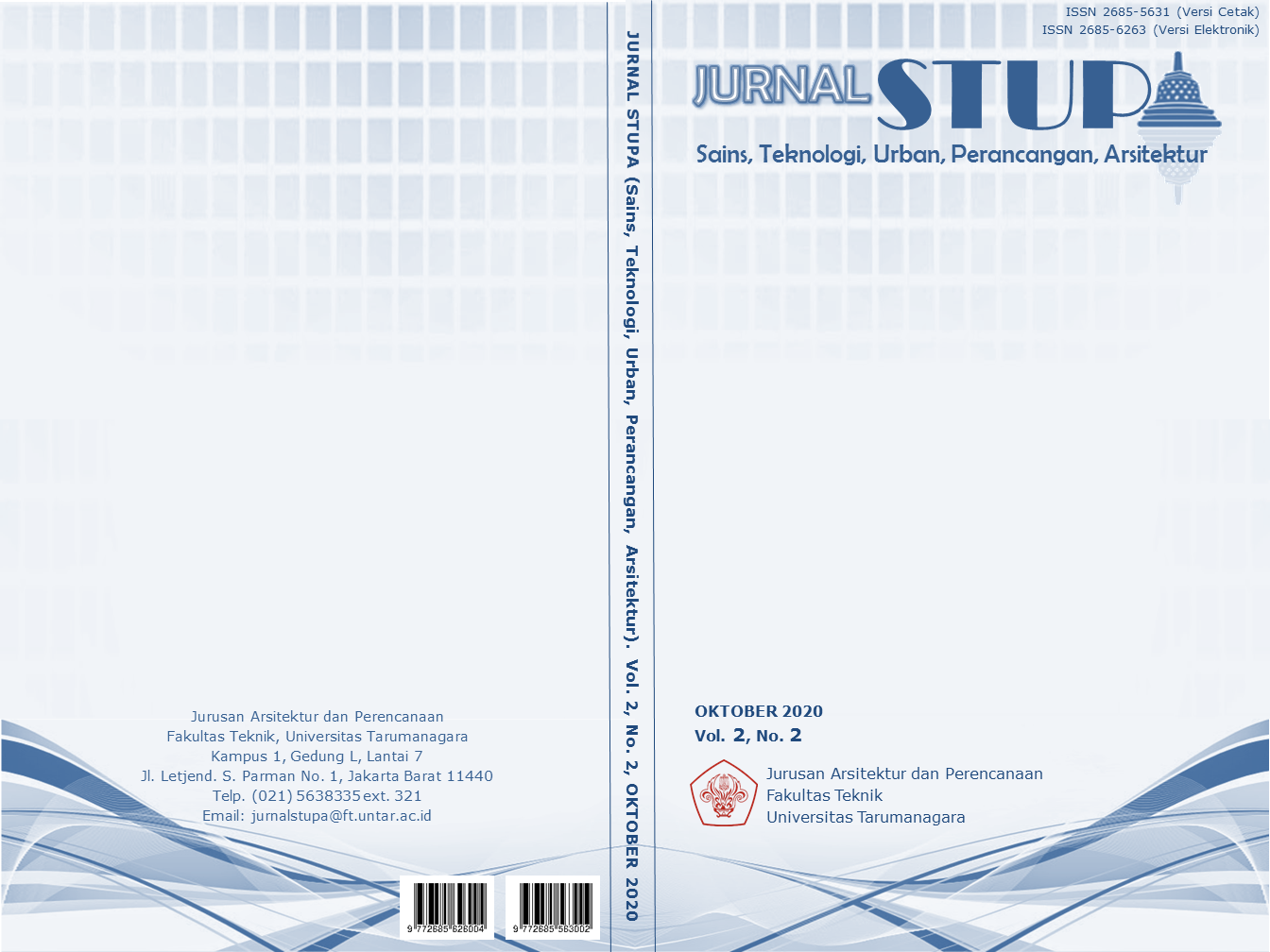LOKA LOAK KEBAYORAN LAMA
Main Article Content
Abstract
The existence of transit hubs is a prominent feature of urban life that hold human movement and interaction, which raises the growth of new places for communities, and a third place that was formed naturally. Kebayoran Lama Utara, which located close to a train station, is not spared by this phenomenon. The place becomes unique by flea markets that sprawls among the hub, forming an image for the site, which unfortunately placed where it should not be. It becomes an irony, where a distinctive feature of a place is so potential to be developed, but also becomes the ‘parasite’ of the area itself. Especially with the fact that the site is located in the negative point of the city, but with a lot of human activities. Loka Loak Kebayoran Lama, with urban retrofitting method, aims to develop the area, both within the site, as well as the surrounding and the communities in one system, to fulfill the functions both socially and economically, but also environmentally sustainable. The project also inspired and maximized the surrounding situation, with the use of an abandoned shophouse as a base structure, and the approaches to the urban patterns. Project is designed to be context to the surroundings, but also dynamic. So, the existence of the project doesn’t become the ‘alien’ of the area, but the catalyst, and improves the image of the region. Activities on the project are maximized to be enjoyed by four main groups which are; the merchants, vendees, the locals, and the commuters. Commercial area to gather the buying and selling activities, combined with the education and entertainment programs, which also linked to the supporting functions for the transit activities. These programs make the project can be a place with diverse activities, and also a new public space at a negative point in an active urban area.
Keywords: flea market; loka-loak Kebayoran Lama; third place; transit hub; urban retrofitting
Abstrak
Keberadaan suatu pusat transit sebagai tempat perpindahan memunculkan titik-titik baru berkumpulnya masyarakat, yang secara tidak langsung dan spontan menjadi third place baru. Kebayoran Lama Utara, yang terletak erat dengan stasiun kereta api tidak luput oleh fenomena tersebut. Tempat penjualan barang loak yang unik dan membentuk citra menjadi marak di sekitar tapak, yang sayangnya tidak di tempat yang seharusnya. Sehingga ironi, dimana sebuah potensi yang dapat mengembangkan, menjadi sesuatu yang tidak seharusnya. Terlebih tapak merupakan titik negatif yang kurang efektif, namun ramai oleh aktivitas masyarakat. Loka Loak Kebayoran Lama, dengan metode urban retrofitting, bertujuan untuk mengembangkan area tersebut, baik di dalam tapak, lingkungan sekitar, serta masyarakatnya dalam satu sistem memenuhi fungsi baik sosial, ekonomi, maupun lingkungan berkelanjutan. Proyek terinspirasi dan memaksimalkan situasi sekitar, dengan pemanfaatan struktur ruko terbengkalai, serta pendekatan urban pattern sekitar. Bentukan konteks dan teratur, namun dinamis. Sehingga keberadaan proyek dapat menjadi katalis, serta meningkatkan citra kawasan. Kegiatan dimaksimalkan untuk empat kelompok utama yaitu; pedagang, pembeli, warga, dan komuter. Kesimpulan perancangan, adalah Loka Loak Kebayoran Lama, dengan area pasar loak sebagai titik kegiatan jual beli, berpadu dengan fungsi edukasi serta entertainment, yang bertautan dengan fungsi pendukung kegiatan transit. Aktivitas tidak hanya sebatas jual beli, namun juga edukasi dan hiburan. Proyek dapat menjadi tempat kegiatan yang beragam, dan ruang publik baru di titik negatif dalam kawasan urban yang aktif.
Article Details
Section
References
Darmawan, E. (2005). Ruang Publik Dan Kualitas Ruang Kota.
Frey, H. (1999). Designing the City, Towards a more Sustainable Urban Form. E & FN SPON.
Jones, E. D., & Williamson, J. (2009). Retrofitting Suburbia: Urban Design Solutions for Redesigning Suburbs. John Wiley & Sons Inc.
Malano, H. (2011). Selamatkan Pasar Tradisional: Potret Ekonomi Rakyat Kecil. Jakarta: Gramedia Pustaka Utama.
Oldenburg, R. (1997). The Great Good Place. Cambridge: De Capro Press.
Sassi, P. (2015). Strategies for Sustainable Architecture. Routledge.
Sofiana, R., Purwantiasning, A. W., & Anisa. (2014). Strategi Penerapan Konsep Adaptive Reuse Pada Bangunan Tua Studi Kasus: Gedung PT P.P.I (Ex. Kantor PT Tjipta Niaga) di Kawasan Kota Tua Jakarta. Seminar Nasional Sains dan Teknologi 2014 Fakultas Teknik Universitas Muhammadiyah Jakarta.
Statistik Transportasi DKI Jakarta. (2018). Badan Pusat Statistik Provinsi DKI Jakarta.

